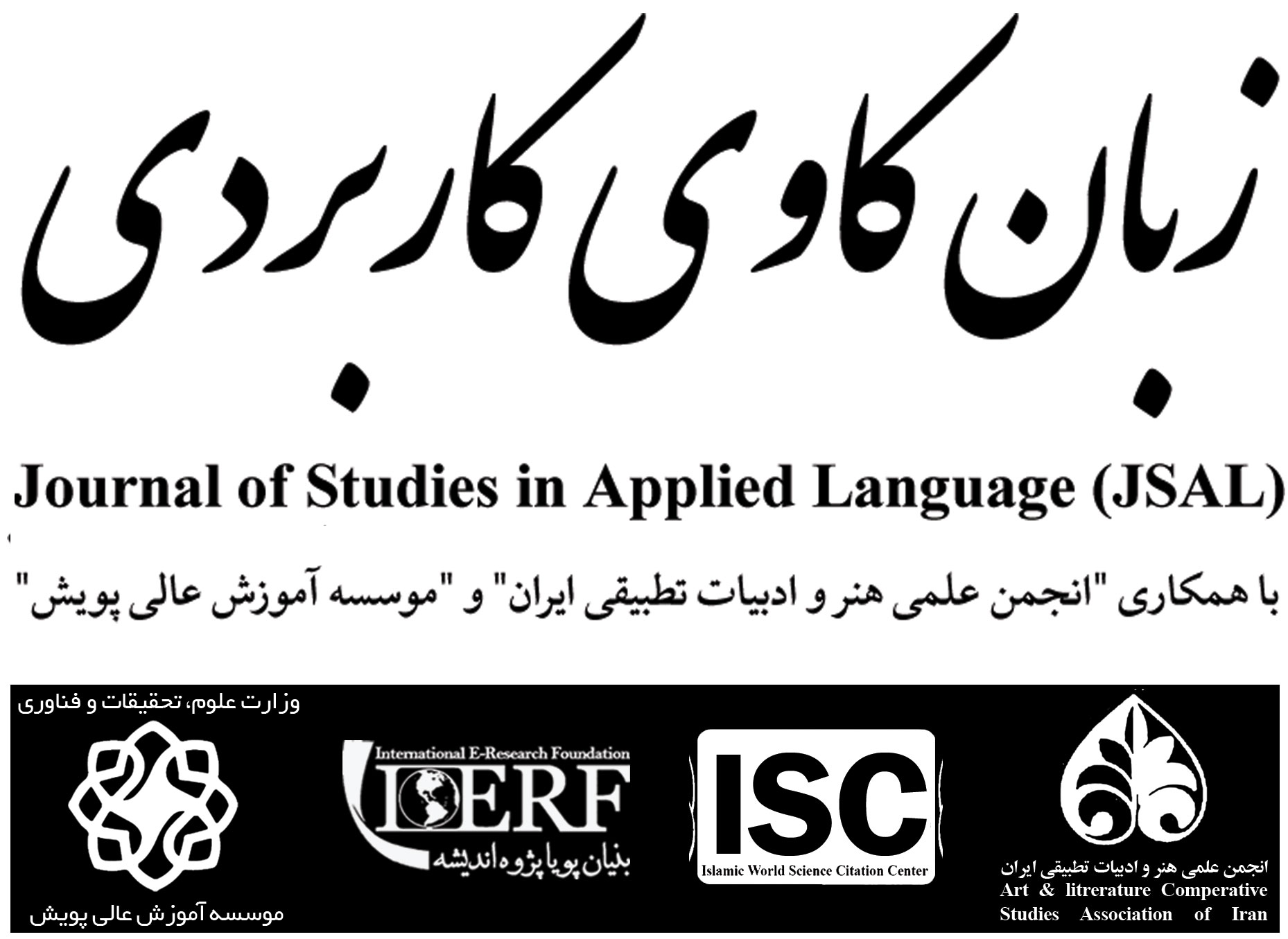<>
Volume 8, Issue 1 (2-2025)
JSAL 2025, 8(1): 79-118 |
Back to browse issues page
Download citation:
BibTeX | RIS | EndNote | Medlars | ProCite | Reference Manager | RefWorks
Send citation to:



BibTeX | RIS | EndNote | Medlars | ProCite | Reference Manager | RefWorks
Send citation to:
Khosravi Dastgerdi Z, Naseri Karimvand A. (2025). Explication of the Structure of Simple Persian Verbs and Their Governing Principles, With an Emphasis on Root Types and Morpheme Formation; A Linguistic Perspective [In Persian]. JSAL. 8(1), 79-118.
URL: http://jsal.ierf.ir/article-1-163-en.html
URL: http://jsal.ierf.ir/article-1-163-en.html
1- Assistant Professor, Department of Persian Language and Literature, Hamedan Branch, Islamic Azad University, Hamedan, Iran , khosravi.ph@gmail.com
2- MA, General Linguistics, Hamedan Branch, Islamic Azad University, Hamedan, Iran
2- MA, General Linguistics, Hamedan Branch, Islamic Azad University, Hamedan, Iran
Abstract: (1761 Views)
The verb represents the most fundamental element across all global languages (a universal linguistic feature). Verbs occupy a central role within the framework of grammatical concordance (agreement between verb and subject). Language, as a dynamic social construct, generates an unlimited array of sentences for communication using a finite set of phonemes, linguistic symbols, and syntactic rules. While maintaining its communicative efficacy, language reshapes linguistic constructs in alignment with the principle of least effort, modifying the phonological-syllabic composition of words (alterations in vowel quality and duration, consonant harmony or disharmony, and the implementation of comprehensive phonological processes) to enhance articulatory ease. Such transformations occasionally introduce ambiguities in the precise identification of linguistic construct components (here, verbs). Nevertheless, it is unreasonable to resolve this superficial issue by positing numerous past-tense morphemes (ranging from 8 to 10). The researchers maintain that only a single past-tense morpheme (t/d) exists, which undergoes modifications due to its sequential interaction with adjacent phonemes. This analysis investigates these alterations and their scientific underpinnings. This study aims to ascertain the past-tense morpheme in ostensibly simple Persian verbs, elucidate the emergence of multiple past-tense morphemes, and clarify the varieties of roots in simple verbs. Essentially, this research responds to the following inquiries: What constitutes the past-tense morpheme in Persian? Why is the notion of multiple past-tense morphemes scientifically untenable? Can phonological processes explain the variations in past-tense roots and stems, thereby negating the need to propose diverse past-tense morphemes? How are Persian past-tense morphemes—such as {ت (kusht), د (gostard), آد (istād), ید (kharid), ِست, یست (negarest, negārist), ُفت (paziroft), …}—interpreted and analyzed? What is the composition of so-called derived verbs? Are the past and present stems of a verb derived from a unified root? The findings, derived through a descriptive-analytical approach utilizing documentary evidence and a morphological perspective, delineate the stages of verb formation and underscore the efficacy of specific phonotactic constraints within the verb system. Significantly, the notion of multiple past-tense morphemes lacks linguistic legitimacy when evaluated against principles such as least effort, phoneme co-occurrence restrictions, and phonological processes. The past-tense morpheme is exclusively /t/, a vestige of the Old Persian participial suffix -ta. In modern Persian, verbs categorized as transformational are seldom employed, as native speakers predominantly favor and have embraced the construction of compound verbs derived from the same root.
Keywords: 0
Type of Study: Research |
Subject:
Linguistic research
Received: 2024/11/11 | Accepted: 2025/01/17 | Published: 2025/03/2
Received: 2024/11/11 | Accepted: 2025/01/17 | Published: 2025/03/2
References
1. Bartholomae, C., (1961) Altiranisches Worterbuch, Strassburg, Berlin. [In English] [DOI:10.1515/9783111471778]
2. Horn, P., (1893), Grundriss der neupersischen Etymologie, Strassburg. [In English] [DOI:10.1515/9783111699394]
3. Nyberg, H. S, (1974), A Manual of Pahlavi, II: Glossary, Wiesbaden. -
4. Yarmohammadi, L and C. Ronayne (1976). The Persian verb reconsidered archive rientalni, [In English]
5. Anvari, H., & Givi, A., (2011), Persian Grammar, Tehran: Fatemi [In Persian]
6. Tabatabaei, A., (1997), Persian Simple Verb and Word Formation, Tehran: University Press Center. [In Persian]
7. Abolghasemi, M., (1994), Persian Verbs in Dari, Tehran: Qoqnos. [In Persian]
8. Bagheri, M., (2006), "Phonological Differences in the Past and Present Verbs in Persian", Name Anjoman, 3(6). [In Persian]
9. Hassandoost, M., (2014), Etymological Dictionary of the Persian Language, Persian Language and Literature Academy, Tehran: Athar Publications. [In Persian]
10. Khanlari, P., (1986), History of the Persian Language, 2th Edition, Tehran: No Publications [In Persian]
11. Dehkhoda, A.,, (1958), Dehkhoda Dictionary, Tehran: State Printing House of Iran. [In Persian]
12. Gholamhoseinzadeh, G, Jabr M, Dorri N, Abbasi Z. (2018) "Verb Construction in Persian Language". LIRE, 15 (59), pp. 63-86
13. URL: http://lire.modares.ac.ir/article-41-27830-fa.html. [In Persian].
14. Farshidvard, K., (2009), Modern Detailed Grammar, Tehran: Sokhan Publications. [In Persian]
15. Zahra Cheraghi, F. K. (2011). "Phonological Analysis of Modern Persian Irregular Verbs: An Optimality Approach". Language Research, 2(1), pp. 51-82. [In Persian]
16. Goshtasb, F. and Hajipour, N. (2022). "Denominative verbs in Zoroastrian Middle Persian texts (statistical and corpus-based analysis)". Language and Linguistics, 18(35), pp. 1-19. DOI: 10.30465/lsi.2023.44441.1660, [In Persian]
17. Golfam, A., Maleki Moqaddam, A., & Ebrahim Poornik, F. (2018). "Constraints on the Productivity of Denominal and Deadjectival Verbs in Standard Farsi". Research in Western Iranian Languages and Dialects, 6(20), pp. 109-132. [In Persian]
18. Mahoutian, S., (2014) Persian Grammar from a Taxonomic Perspective, Translated by Mehdi Samaei, Tehran: Markaz. [In Persian]
19. Vahidian Kamyar, T., Omrani, G., (2001) Persian Grammar (1), Tehran: Samt. [In Persian]
20. Vafaei, Abbas Ali, (2017), "Verb Construction in in Persian Language", LIRE, 14(55), pp. 131-145. [In Persian].
Send email to the article author
| Rights and permissions | |
 |
This work is licensed under a Creative Commons Attribution-NonCommercial 4.0 International License. |







